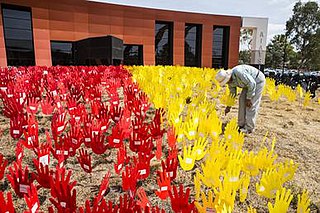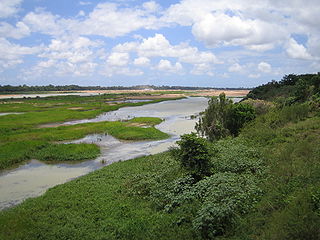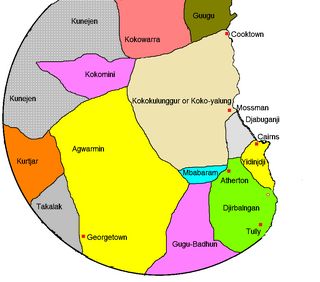Related Research Articles

The Australian Institute of Aboriginal and Torres Strait Islander Studies (AIATSIS), established as the Australian Institute of Aboriginal Studies (AIAS) in 1964, is an independent Australian Government statutory authority. It is a collecting, publishing, and research institute and is considered to be Australia's premier resource for information about the cultures and societies of Aboriginal and Torres Strait Islander peoples.

The Lower Burdekin languages were probably three distinct Australian Aboriginal languages spoken around the mouth of the Burdekin River in north Queensland. One short wordlist in each was collected in the 19th century, and published in the second volume of The Australian Race in 1886. These languages have since gone extinct, with no more having been recorded. Due to the paucity of the available data, almost nothing of their grammatical structure is known.
Ngardi, also spelt Ngarti or Ngardilj, is an Australian Aboriginal language that is considered moribund. It was previously thought to be an alternative name for the Bunara language, but these are now classified as separate languages. It was/is spoken by the Ngarti people of the Northern Territory and northern Western Australia.
Matngele or Madngele is an extinct Australian Aboriginal language of the Northern Territory spoken by the Madngella and Yunggor peoples.

The Paman languages are an Australian language family spoken on Cape York Peninsula, Queensland. First noted by Kenneth Hale, Paman is noteworthy for the profound phonological changes which have affected some of its descendants.
Bidjara, also spelt Bidyara or Pitjara, is an Australian Aboriginal language. In 1980, it was spoken by 20 elders in Queensland between the towns of Tambo and Augathella, or the Warrego and Langlo Rivers. There are many dialects of the language, including Gayiri and Gunggari. Some of them are being revitalised and are being taught in local schools in the region. The various dialects are not all confirmed or agreed by linguists.
Dhauwurd Wurrung is a term used for a group of languages spoken by various groups of the Gunditjmara people of the Western District of Victoria, Australia. Keerray Woorroong is regarded by some as a separate language, by others as a dialect. The dialect continuum consisted of various lects such as Kuurn Kopan Noot, Big Wurrung, Gai Wurrung, and others. There was no traditional name for the entire dialect continuum and it has been classified and labelled differently by different linguists and researchers. The group of languages is also referred to as Gunditjmara language and the Warrnambool language.
Yaygir, also spelt Yaygirr or Yegir, is an Australian Aboriginal language. It was spoken by the Yaygir people in the Northern Rivers region of New South Wales.
Mbariman-Gudhinma, one of several languages labelled Gugu Warra 'unintelligible speech' as opposed to Gugu Mini 'intelligible speech', is an extinct dialect cluster of Aboriginal Australian languages of the Cape York Peninsula in northern Queensland, Australia. Another one in the group is Wurangung, also known as Yadaneru or Jeteneru.
Mbara, and Yanga are mutually intelligible but separate Aboriginal language of Queensland, both now extinct. Glottolog assigns a code to a group level as Mbara-Yanga (mbar1254). Yanga is not to be confused with the Yangga language, a dialect of Biri.
Guugu Yalandji, also spelt Kuku-Yalanji, is an Australian Aboriginal language of Queensland. It is the traditional language of the Kuku Yalanji people.
Ngura is a disputed and possibly spurious ethnic and language designation of central Australia. The name 'Nura', short for Ngurawarla, means 'empty camp', referring to lands abandoned after a massacre. It is not a language or ethnic designation.
Wanggamala, also spelt Wanggamanha, Wangkamahdla, Wangkamadla, Wangkamanha, Wangkamana, Wonkamala, Wongkamala, Wonkamudla, and other variants, is an extinct Australian Aboriginal language of the Pama–Nyungan family, previously spoken in the Northern Territory around Hay River and to the south of the Andegerebinha-speaking area.
Mayi-Kutuna, also spelt Mayaguduna, Maikudunu and other variants, is an extinct Mayabic language once spoken by the Mayi-Kutuna, an Aboriginal Australian people of the present-day Cape York Peninsula in northern Queensland, Australia.

Anaiwan (Anēwan) is an extinct Australian Aboriginal language of New South Wales. Since 2017, there has been a revival program underway to bring the language back.
Biri, also known as Biria, Birri Gubba, Birigaba, Wiri, Perembba and other variants, is an Australian Aboriginal language of the Mackay area of Queensland spoken by the Birri Gubba people. There are at least eight languages regarded as dialects of Biri, and two which are related but whose status is not yet fully determined. All are covered in this article.
Gkuthaarn, also rendered Kuthant, Kutanda and other variant spellings, is an extinct Paman language of the Cape York Peninsula, Queensland, Australia. It also known as Karundi/Garandi, but the Garandi language may be a separate dialect.

Wamin, also known as Agwamin or Ewamian, is an Australian Aboriginal language of North Queensland spoken by the Ewamian people. Wamin was traditionally spoken in the Etheridge region, in the areas around Einasliegh, Georgetown, and Mount Surprise.
Bugurnidja is an Australian Aboriginal language of Arnhem Land in northern Australia. Almost nothing is known of it; apparently Nicholas Evans collected some data from a single speaker, and this showed similarities to Ngomburr.
The Wakaman people, also spelt Wagaman, are an Aboriginal Australian people of the state of Queensland. According to some authorities, they may be interchangeable with the group identified by ethnographers as the Agwamin.
References
- ↑ N33 Kamu at the Australian Indigenous Languages Database, Australian Institute of Aboriginal and Torres Strait Islander Studies